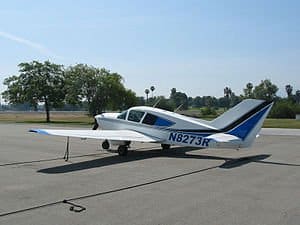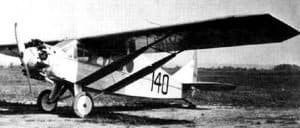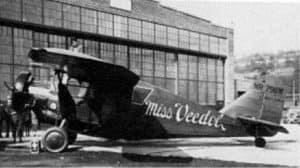
Bellanca
The Bellanca is a single-engine, piston aircraft with retractable gear. The Bellanca is a low-wing airplane produced by Bellanca Aircraft (now Alexandria Aircraft) between the years 1965 and 2002. It seats up to 3 passengers and 1 pilot.
Specifications Super Viking 17-30 A
Exterior Dimensions
Wing span: 34 ft 2 in
Length: 26 ft 4 in
Height: 7 ft 4 in
Weights
Max TO weight 3,325 LBS
Empty Weight: 2,185 LBS
Maximum Load: 1140
Fuel capacity: 68 GAL
Engine
Manufacturer: Continental Motor
Model: IO-520-D/K
Horsepower: 300 HP
Overhaul (HT): 1700/1900 hr TBO
Years before overhaul: 12
Performance specifications on Model 17-30A
| Horsepower: 300.00 | Gross Weight: 3,325 |
| Top Speed: 181 | Empty Weight: 2,185 |
| Cruise Speed: 176 | Fuel Capacity: 68 |
| Stall Speed (dirty): 61 | Range: 550 |
| Rate of Climb: 1,210 | Rate of Climb (One Engine): |
| Service Ceiling: 20,000 | Ceiling (One Engine): |
| Takeoff | Landing |
| Ground Roll: | Ground Roll |
| Takeoff Roll Over 50 ft: 1,420 | Landing Roll Over 50 ft: 1,340 |
VIEW SPECIFICATIONS ON OTHER MODEL BELLANCAS
History
Early Bellancas
The Bellanca company had a long pre-WWII history of building efficient light aircraft. Giuseppe Mario Bellanca emigrated to the United States from Italy and was an early builder of aircraft in the 20's. He established a reputation for designing highly efficient and fast aircraft starting with the Bellanca CF series. Eventually G. M. Bellanca came to work for the Wright company, where he was commissioned to design an airplane to showcase the Wright company's new J-5 Whirlwind radial engine, the first truly reliable aircraft engine.
Wright-Bellanca
The resulting airplane was the Wright-Bellanca, which Charles Lindbergh tried to purchase for his transatlantic trip. Unfortunately for Bellanca, the owners of the airplane played games. They informed Lindbergh that they'd be happy to sell the airplane but that they would name their own pilot. Lindbergh understandably walked away and took his business to Ryan, and subsequently made history with the Spirit of St. Louis (also powered by a Wright Whirlwind).
It was a close thing, though, because the Wright-Bellanca was ready to fly through the spring of 1927 leading up to Lindbergh's flight and both planes were located at Roosevelt Field near New York City. What kept the Wright-Bellanca on the ground was not mechanical problems but the courts, since the owners were suing each other over who would be the pilot. Ultimately, the Wright-Bellanca, named Miss Columbia, did make a transatlantic flight from New York to Berlin two weeks after Lindbergh's milestone.
In many ways the Miss Columbia flight was more interesting technically, since the Wright-Bellanca was a general purpose airplane seating more than one passenger. The only modifications for its transatlantic flight consisted of removing the rear seats and replacing them with extra fuel tanks. By contrast, The Spirit of St. Louis was purpose-built for the transatlantic flight and only carried one passenger in an awkward blind cockpit. Lindbergh did, however, have the vision, innovative ideas about navigation, and ultimately had the will to make the flight and make it first, and he deserves his place in history along with his airplane.
Further Development
G. M. Bellanca found new, more upstanding, financial backers and continued to build airplanes. Descendents of the Miss Columbia evolved into the CH series, which were used in numerous famous and record-setting flights. One of the most notable was the Miss Veedol, flown by Clyde Pangborn on the first nonstop flight across the Pacific in 1931 from Japan to Wenatchee, Washington. To save weight the wheels were jettisoned after takeoff, and the aircraft belly landed (e.g. crashed) upon arrival. A replica known as the Spirit of Wenatchee is currently being constructed to commemorate this flight.
G.M. Bellanca's designs turned out to be excellent bushplanes, and his Pacemaker and Skyrocket designs saw extensive use in Canada, Alaska, and bush locations around the world. One of the most interesting looking is this Aircruiser, which is located at the Tillamook Air Museum in Oregon. This aircraft is huge and has the distinctive Bellanca airfoil-struts.
(Read about the aviation pioneer Giuseppe Mario Bellanca.)
Bellanca Cruisair (1946-1958)
The Bellanca 14-7 Cruisair and its successors were a family of single-engined light aircraft manufactured in the United States from the mid-1930s onwards.
Design and development
Bellanca established itself in the market for 6-8 seat aircraft, but believed that it could also successfully sell smaller 3-4 seat aircraft. To fill this niche Bellanca designed The '14-7 Cruisair' as a modern, low-wing cantilever monoplane with a fuselage intended to contribute lift to the design. Although the prototype flew with fixed tailwheel undercarriage, the 14-9 production version was the first US light aircraft to be mass-produced with retractable undercarriage, the main wheels rotating aft into wheel-wells in the wings, with approximately 50 produced before production was interrupted by World War II.
After WWII Bellanca resumed production with the up-dated Bellanca 14-13 Cruisair Senior, retaining the Bellanca 14-7's basic design, featuring an enlarged cabin, a horizontally opposed Franklin 6A4-335-B3 150 hp (112 kW) engine in place of the earlier models' Le Blond radial and an oval vertical endplate on each horizontal stabilizer. This latter feature gained the type the affectionate nickname “Cardboard Constellation”, because the arrangement is similar to the contemporary Lockheed Constellation airliner.
The naming convention for Bellanca aircraft was followed with the Cruisair series, with the first number giving the wing area in square feet, (dropping the final digit), while the second number is the aircraft's horsepower, (again dropping the final digit).
Construction of the series is fairly conventional with wings constructed of spruce with plywood skin and fuselages built up from a welded steel-tube framework with a fabric covering. A constant process of refinement led to many variants, sometimes given new names but retaining the same structure differing only in powerplant, minor details and furnishings. The only major variations were the introduction of a single swept fin and tri-cycle retractable undercarriage. Production was carried out at a variety of companies, including Bellanca, Downer, Aviabellanca, Northern Aircraft and Inter-Air, with little variation other than powerplant and furnishings.
The highly responsive flying characteristics of the aircraft are evident to anyone who has flown one. Bill Cox, the well known aviation journalist at Plane and Pilot Magazine commented regarding the flying qualities of Vikings that they “have long been famous for control response and harmony that seems almost psychic in nature”, and asserted, “Owners almost unanimously pronounce the Viking the best handling airplane they've ever flown.”
Pre-war development culminated in the 1941 14-12, at which point production ceased to allow Bellanca to work as a military subcontractor for the duration of the war when an attempt to market a militarized version as a trainer was unsuccessful. After the war, Bellanca returned to the design to create the Bellanca 14-13 and its successors.
Bellanca Cruisair Senior Model 14-13 (1946-1948)
While retaining the Bellanca 14-7's basic design, the 14-13 featured an enlarged cabin, a horizontally opposed Franklin 6A4-335-B3 150 hp (112 kW) engine in place of the earlier models' Le Blond radial and an oval vertical endplate on each horizontal stabiliser. This latter feature gained the type the affectionate nickname “cardboard Constellation”, because the arrangement was similar to the contemporary Lockheed Constellation airliner
Taking its name from the Bellanca tradition of identifying the series from the wing area in square feet, dropping the final digit, while the second number was the aircraft's horsepower, again dropping the final digit, the 14-13 did not quite fit the naming convention. The Bellanca 14-13 wing was constructed of wood, while the fuselage was welded steel-tube framework with a fabric covering.
The 14-13 was introduced in 1946; in its improved 14-13-3 version the aircraft remained in production until 1956.
Bellanca Cruisemaster 190 Model 14-19 (1950-1958)
A higher performance design revision was granted FAA approval as the 14-19 Cruisemaster on September 26, 1949. The new model featured structural upgrades, a 190 hp Lycoming O435-A engine, an increased gross weight of 2,600 lbs, hydraulically operated landing gear and flaps, and a deluxe interior. 99 of these airplanes were produced between 1949 and 1951. Externally, a near-look-alike to the earlier models, this version was distinguished by its larger, oval-shaped endplates. All production ceased in 1956 as Bellanca wound up its operations.
Bellanca Cruisemaster 230 Model 14-19-2 (1959)
The 14-19 design was revived by Northern Aircraft and granted FAA approval on January 7, 1957 as the 14-19-2 Cruisemaster. The new model featured a 230 hp Continental O-470K engine, an increased gross weight of 2,700 pounds, an updated instrument panel as well as new paint and upholstery schemes. The 14-19-2 was the last taildragger. 104 of these airplanes were produced between 1957 and 1958.
Bellanca 260, Viking and Super Viking (1959-2002)
The Bellanca Viking and Super Viking are a series of single-engine, four-seat, high performance, retractable gear aircraft manufactured in the USA during the 1960s and 1970s. A total of 1,356 Vikings have been produced with most production between 1968 and 1975 (1019 planes).
Development and design
The Viking is a derivative of the Bellanca Cruisair, a retractable gear taildragger with two extra vertical fins on the tips of the horizontal stabilizer. The 14-13 Cruisair series was developed into the larger, more powerful 14-19 Cruisemaster in the early 1950s. After the original Bellanca company went out of business, Downer Aircraft took over the type certificate and built the 14-19-2 Cruisemaster by mating the airframe with a Continental O-470 of 230 hp. In 1958, Downer redesigned the airplane with a nosewheel and fuel injected IO-470 of 260 hp, and redesignated it the 260. The 14-19-3 260 retained the wire-braced triple tail into the 1962 model year. After that year the triple tail design was modified to a single tail with the same aggregate surface area, and manufactured as the Model 260A. The later Vikings retain the oversized vertical fin that contributes to the distinctive flying characteristics of the aircraft. The Viking model was born out of discussions at Downer for a bigger version of the “Model 260” with at least 300 horsepower. The company was based in Minnesota and employed skilled craftsman who manufactured the wing from spruce and the new 300 hp model was named the “Viking” in respect to the many Scandinavians of the area.
The first Model 17 Viking appeared in 1966 called the “17-30.” It was powered by a 300 hp Continental IO-520-D. In 1969 a Viking powered by a 290 hp (later 300 hp) Lycoming IO-540 was introduced, either normally aspirated (17-31) or turbocharged (17-31TC).
Over the years there were a number of refinements to the aircraft. The original hydraulic gear and flap actuation system was redesigned in 1968 introducing electric flaps. In 1969 the FAA issued Type Certificate A18CE and the aircraft built under that design were designated the “A” series “Super Vikings”. Aside from refinements already made to late Viking 300 models, the new 300A Vikings (17-30A, 17-31A and 17-31ATC) had a gross weight increase to 3,325 lbs. The original complex fuel system with five tanks and two fuel selectors allowing eight possible combinations of selector settings was simplified to a left, right and auxiliary system in 1974. After several years of financial losses, Viking sales became profitable again in 1978. In 1979, Continental-powered Vikings sported a fully enclosed nosewheel thanks to a redesign of the engine mount. This necessitated the use of cowl flaps for the first time on the Viking but resulted in a 12 mph increase. In 1979 production of the Lycoming-powered 17-31A ceased. In 1996, the Continental IO-550 was made available as an option.
Since 2002 the company has been operated by a group of six Bellanca enthusiasts who bought the company from the state of Minnesota and established Alexandria Aircraft Co. LLC. They provide technical support and parts to owners and A&Ps in the field. They have sold one new aircraft, manufactured in 2005.
The aircraft fuselage is constructed from tubular steel overlaid with fabric while the wings are fashioned from spruce with a plywood skin.
Bill Cox, an aviation journalist at Plane and Pilot Magazine commented regarding the flying qualities of Vikings that they “have long been famous for control response and harmony that seems almost psychic in nature”, and asserted, “Owners almost unanimously pronounce the Viking the best handling airplane they've ever flown.”
Variants
Downer Bellanca 260 Model 14-19-3 (1959-1961)
Northern Aircraft became the Downer Aircraft Company in 1959, and introduced the 14-19-3 “260,” a considerably more powerful Cruisemaster with a 260-hp Continental, tricycle landing gear, and other refinements.
The 1960 Bellanca 260 is a development of the Cruisemaster, which it now supersedes. The main change is the installation of the Continental IO-470-F fuel-injection 260 h.p. engine (1500 TBO), a generous power unit for the gross weight of 2,7001b, but one which can offer a useful balance of performance and economy.
The 14-19-3 260 retained the wire-braced triple tail into the 1962 model year. After that year the triple tail design was modified to a single tail with the same aggregate surface area, and manufactured as the Model 260A.
Bellanca 260A Model 14-19-3A (1964-1968) Serial Numbers 4230 through 4342
Inter-Air acquired production rights in 1962, and the 260A received its first conventional tail section. Shortly afterwards, Inter-Air became known as the Bellanca Sales Company, a subsidiary of Miller Flying Service. The engine was a Continental 260hp TBO 1500/1700
IO-470-K.
Bellanca Viking 300 Model 17-30 (1967-1970) Serial Numbers 30000 through 30262
The Viking model was born out of discussions at Downer for a bigger version of the “Model 260” with at least 300 horsepower. The company was based in Minnesota and employed skilled craftsman who manufactured the wing from spruce and the new 300 hp model was named the “Viking” in respect to the many Scandinavians of the area.
The first Model 17 Viking was designed in 1966 and delivered as a 1967 year model called the “17-30.” It was powered by a 300 hp Continental IO-520-D.
Over the years there were a number of refinements to the aircraft. The original hydraulic gear and flap actuation system was redesigned in 1968 introducing electric flaps.
Bellanca Viking 300 Model 17-31 (1969) Serial Numbers 3201 through 3214
In 1969 a Viking powered by a 290 hp (later 300 hp) Lycoming IO-540 (2000 TBO) was introduced, either normally aspirated (17-31) or turbocharged (17-31TC).
Bellance Viking 300 Model 17-31TC (1969) Serial Numbers 31001-31003
Four-seat light cabin aircraft, powered by a (300-hp) Lycoming IO-540 (2000 TBO) piston engine, the aircraft is fitted with turbocharger.
Bellanca Super Viking 300A Model 17-30A (1970-2002) Serial Numbers 30263 through 31033 & up
In 1969 the FAA issued Type Certificate A18CE and the aircraft built under that design were designated the “A” series “Super Vikings”. Aside from refinements already made to late Viking 300 models, the new 300A Vikings (17-30A, 17-31A and 17-31ATC) had a gross weight increase to 3,325 lbs. The 17-30A has a Continental IO-520-K 300 hp engine (1700TBO).
IO-550 power option starts with 1997 model.
Bellanca Super Viking 300A Model 17-31A (1970-1977) Serial Numbers 32-15 through 32-171
Four-seat light cabin aircraft, powered by a (300-hp) Lycoming IO-540-K1E5 (2000 TBO) piston engine.
Bellanca Turbo Super Viking Model 17-31ATC (1970-1979 ) Serial Numbers 31004 through 31155
Four-seat light cabin aircraft, powered by a 224-kW (300-hp) Lycoming IO-540-K1E5 piston engine, the aircraft is fitted with two Rajay turbochargers.



